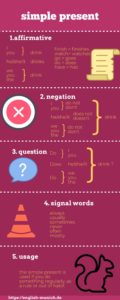simple present
The simple present is mostly used when actions are executed regularly.
typical signal words:: sometimes, usually, never, always, often, every day, mostly
example: He alwas goes to the gym.
He goes to the gym on a regular basis, therefore: simple present.
formation:
The formation of the simple present is not really a big problem. All you have to do is to add an "s" in the third person singular. All other forms use just the infitive.
| I/you/we/they | drink |
| he/she/it | drinks |
Of course, there are some exceptions:
After a sibilant, such as (sh, ch), you will have to add - es
| I/you//we/they | catch | wash |
| he/she/it | catches | washes |
If the penultimate letter is a consonant, -y + s turns into -ies:
| I/we/you/they | fly | try | hurry | study |
| he/she/it | flies | tries | hurries | studies |
but: If the penultimate letter before -y is a vowel , -y remains: plays, stays,
have, do use special forms in the third person singular
| I/you/we/they | an offer | go | do |
| he/she/it | has | goes | does |
To be is completely irregular. be ist komplett unregelmäßig:
| I | I am |
| he/she/it | is |
| we/you/they | are |
negation
The English language negates a statement by using the auxiliary do. So if you don't like Coke, you don't not like Coke. Makes sense? do not (don’t) respectively does not (doesn’t) .I don’t like Coca Cola.” also “Ich tue Coca Cola nicht mögen.” bedeuten. Etwas merkwürdig, aber mit etwas Übung kein Problem.
| I/you/we/they | do not don't | play. |
| he/she/it | does not doesn't | play. |
! Therefore, do not negate like this: I not play football. Or: I play football not.
Also, pay attention to the third person singular:
After the negation by does not, doesn’t the main verb loses its dangling -s.
She doesn’t like(no s) football.
The third person singular is sufficiently defined by the -s inside the auxiliary doesn't.
Question
Just as the negation, also the question, uses the auxiliary do to turn a statement into a question.
For example: Do you like Coca Cola?
| Do | I/you/we/they | play? |
| Does | he/she/it | play? |


